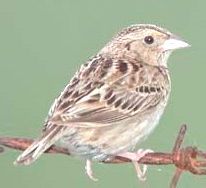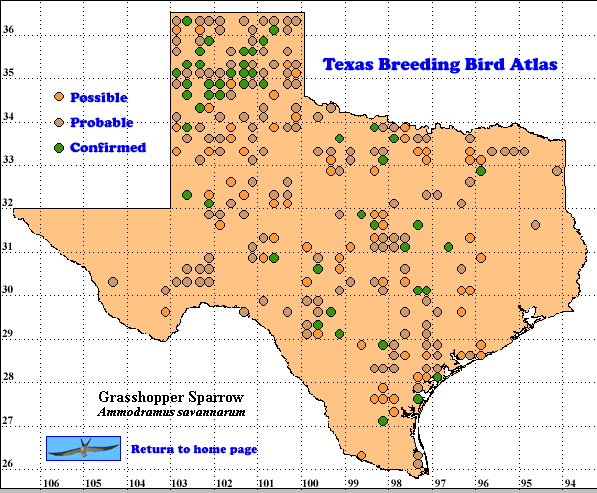The number of breeding sites for this sparrow on the TBBA map is a real tribute to the skill and perseverance of the atlasers. Grasshopper Sparrows are one of the most elusive of sparrows. Their soft, insect-like vocalizations are easy to overlook and these sparrows often walk or run on the ground, rather than flying. Even when they do fly on their breeding or wintering grounds, the flight is usually low and for only a short distance before the bird drops into cover (Vickery 1996, RCT).
DISTRIBUTION. During the 1987-1992 field work seasons of the TBBA project, observers found breeding evidence for Grasshopper Sparrows in all regions of Texas, although sites were few in the Trans-Pecos an Pineywoods. The northern Panhandle had the densest concentration of sites. The TBBA map is similar to the map of 1994-2003 North American Breeding Bird Survey (BBS) data (Sauer et al. 2007). The map in Vickery (1996) also shows breeding in all parts of Texas except the Pineywoods and Trans-Pecos and adjacent to the Rio Grande River (see the region map in Lockwood and Freeman (2004).
Across North America the BBS found the highest relative abundances (as high as 10-30 sparrows per route per year) on the Great Plains from North Dakota to Texas and east to Illinois. Other pockets of dense breeding include eastern Washington and adjoining Canadian prairies, the Appalachian foothills from Georgia to Pennsylvania and the California coast. Breeding occurs at low densities through most of the rest of the United States and southern Canada, excluding high elevation areas, dense forests, deserts, the Gulf Coastal Plain and Florida. BBS data and the Arizona Breeding Bird Atlas also indicate breeding occurs in southeast Arizona (Corman 2005, Sauer et al. 2007) although this is not shown on the map in Vickery (1996).
In winter most Grasshopper Sparrows move south to the Gulf and south Atlantic coastal plains, southeast Arizona to southern Texas, Mexico, Central America and Cuba. Resident populations also exist in limited areas of south Georgia and central Florida, northwestern South America and some larger Caribbean islands (Vickery 1996, Am. Ornithol. Union 1998)
SEASONAL OCCURRENCE. Grasshopper Sparrows are present all year in Texas. Most wintering sparrows are found south of the Nueces River. Spring migrants arrive from mid-March to mid-May. . These sparrows breed from early April to late July, based on egg collection dates from April 20 to July 24. Southbound migrants are uncommon to common in most of Texas from late July to mid-November (Oberholser 1974, Lockwood and Freeman 2004).
BREEDING HABITAT. Grasshopper Sparrows breed in Texas from near sea level to about 850 m (2800 fr) in prairies and rangelands with scattered bushes and small trees (Oberholser 1974). In Oklahoma atlasers mentioned tall- to short-grass prairies, pastures and hayfields (Reinking 2004). In Colorado and Arizona almost all breeding evidence was found in grassland habitats (Kuenning 1998, Corman 2005), consistent with this species reputation as a grass;and sparrow (Vickery 1996),
The female builds the ground nest in 2-3 days, often in a shallow depression of grasses. usually with a dome and a side entrance. Nests are concealed by overhanging vegetation. The outside diameter is 11-14 cm (4.4-5.6 in), height 5-7 cm (2-3 in), inside diameter 6-8.5 cm (2.4-3.4 in) and cup depth 3-4 cm (1-1.5 in; Harrison 1979, Vickery 1996).
In this nest the female usually lays 4-5 (range 3-6) smooth, creamy white eggs, sometimes marked with shades of gray. The eggs are finely overlaid with reddish brown speckles and spots. She incubates the eggs for 11-13 days and the nestlings leave the nest as soon as 6-9 days after hatching. Two broods are usually attempted although the second clutch is usually smaller. Unrelated helpers aid in caring for nestlings at some nests (Harrison 1979, Vickery 1996).
STATUS.The TBBA map for Grasshopper Sparrow shows breeding evidence across a much larger area of Texas than the map in Oberholser (1974), but whether this difference represents a real change in abundance or whether the atlasers were more successful in detecting this secretive and elusive sparrow cannot be determined. Lockwood and Freeman (2004) consider this species to be a rare to locally common summer resident in Texas. BBS observers found relative abundances as high as 3-10 sparrows per route. BBS data from 85 routes produce a statistically significant average annual population change of -2.8% for the period 1980-2006 (Sauer et al. 2007). Although this decline is smaller than the survey wide average of -3.5%, it is still disturbing for the long-term future of Grasshopper Sparrow as a breeding species in Texas. Text by Robert C. Tweit (2008)
Corman, T. E. 2005. Grasshopper Sparrow (Ammodramus savannarum). In Arizona breeding bird atlas. pp. 528-529 (T. E. Corman and C. Wise-Gervais, eds.), University of New Mexico Press, Albuquerque.
Sauer, J. R., J. E. Hines, and J. Fallon. 2007. The North American breeding bird survey, results and analysis 1966-2006. Version 7.23.2007. USGS Patuxent Wildlife Research Center, Laurel MD < http://www.mbr-pwrc.usgs.gov/bbs>

